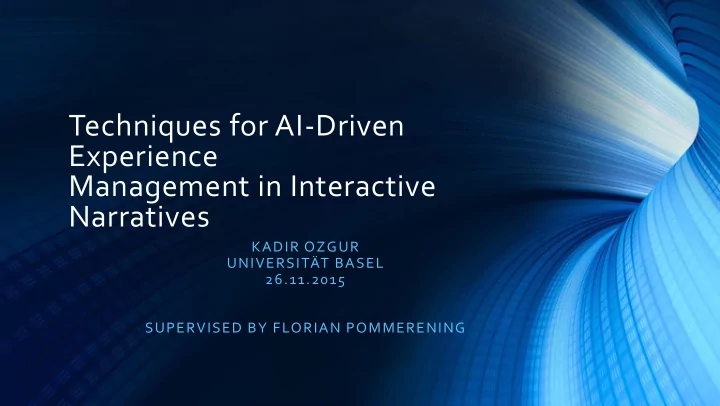

Techniques for AI-Driven Experience Management in Interactive Narratives KADIR OZGUR UNIVERSITÄT BASEL 26.11.2015 SUPERVISED BY FLORIAN POMMERENING
Little Red Riding Hood • Red brings cake to grandmother • Comes across to the wolf • Wolf eats Grandmother • What would be happen if the Red kills the Wolf?
AI-Driven Experience Management Techniques General Overview
Introduction • AI for automated story generation • Author’s goals vs. Player’s goals • AI GM ( Game Master) • Generate stories dynamically • Select based on p lay style, goals, emotions, …
AI-Driven Experience Management Planning Domain Definition Language (PDDL) • Parameters • Preconditions • Effects
AI-Driven Experience Management Techniques General Overview • General Overview • Narrative Generation • Play Style Modeling • Goal Inference • Emotional Modeling • Objective Function Maximization • Machine-Learned Narrative Selection
AI-Driven Experience Management Techniques Narrative Generation • Automated Planner • AI Planner assembles start-to-finish narratives during gameplay • Consistency between GM goals and player goals • Satisfaction of particular story • Dynamically and real time
AI-Driven Experience Management Techniques Play Style Modeling • Narrative selection • Modeling the player as vector of numbers • Canonical RPG Types (F:0.9, M:0.2, S:0.1, T:0.4, P:0.3) • AI GM observation • AI GM real time update
AI-Driven Experience Management Techniques Goal Inference • To AI GM infer the player’s current goals • Player inclinations • What happens if a new killer would be introduced? 0.9 • The player model 0.2 0.9 0.7 0.2 0.4 0.6 ≈ 1.31 (F: 0.9, M: 0.2, S: 0.1, T: 0.4, P: 0.3) 0.1 × 0.1 0.1 0.3 0.6 0.8 0.56 0.4 Normalization of 1.31 • 0.56 ≅ (0.7, 0.3) 0.3
AI-Driven Experience Management Techniques Emotional Modeling • Having idea about player’s current emotions • Appraisal-style model of emotions • (J:0.8, H:0.6,F:0.2, D:0) • An appraisal- style model needs to know the player’s goals and the likelihood of accomplishing • Example; kill or avoid Grendel (0.7, -0.3), player has 50% chance kill and 10% of dying, hopeful at the intensity of 0.5 × 0.7 = 0.35 No longer hope, but joy. Killing is uncertain, there is no joy from it yet. Fear 0.1 * 0.3=0.03 Final: (J:0, H:0.35, F:0.03, D:0)
AI-Driven Experience Management Techniques Objective Function Maximization • Annotation of narratives with respect to different styles of play • Example, introduce Grendel (F: 0.9, M: 0, S: 0, T: 0, P: 0) introduce magic fairy (F: 0, M: 0, S: 0.9, T: 0, P: 0) • Dot product between the player inclination model and each annotation • The narrative with the highest dot product • ( 0.9 0 ) ∙ (0.9 0.3 ) = 0.81 (introduce Grendel) 0 0 0 0.2 0.1 0.4 0 ) ∙ (0.9 0.3 ) = 0.09 (introduce magic fairy) ( 0 0 0.9 0 0.2 0.1 0.4
AI-Driven Experience Management Techniques Machine Learned Narrative Selection • Automatically acquire a mapping from game and player states to the set of alternative narratives • Appropriate when training data are available • Example, Similar with how Internet search engines map user queries to a ranked list of web pages • Implemented by SCoReS approach
Implementation Approaches • PaSSAGE ( Player-Specific Stories via Automatically Generated Events) • PAST ( Player-Specific Automated Storytelling) • PACE ( Player Appraisal Controlling Emotions ) • SCoReS ( Sports Commentary Recommendation System)
Implementation Approaches Player-Specific Stories via Automatically Generated Events (PaSSAGE) • An interactive storytelling system • Uses player modelling to automatically learn a model of the player’s preferred style of play • Combines two techniques: • play style inclination modeling • maximizing a simpler version of the aforementioned objective function • Chooses among story branches
Implementation Approaches Player-Specific Automated Storytelling (PAST) • Combines the AI planner of Automated Story Director (ASD) and the playstyle model of PaSSAGE • Uses a PaSSAGE style model of playstyle inclinations • Automatically update from the player’s actions • Automated Story Director (ASD) to compute narratives
Implementation Approaches Player Appraisal Controlling Emotions (PACE) • Uses four techniques of narrative generation • play style modeling • goal inference • emotion modeling • more advanced type of the objective function • selects the narrative that brings the player closest to the target emotional trajectory • Example, iGiselle
Implementation Approaches Sports Commentary Recommendation System (SCoReS) • Machine-learned narrative selection • Automatically suggest stories for commentators to tell during games • Selects story within library in sport games • Learns offline to connect sports stories • Learned mapping is then used during baseball games to suggest relevant stories
Conclusion • Conflict between authorial and player goals • AI GM and Automated Planning System • Story selection and generation approaches • Implementations
Recommend
More recommend